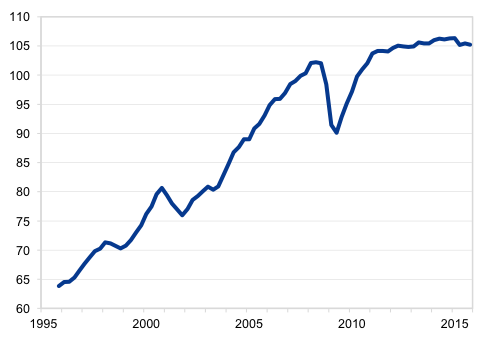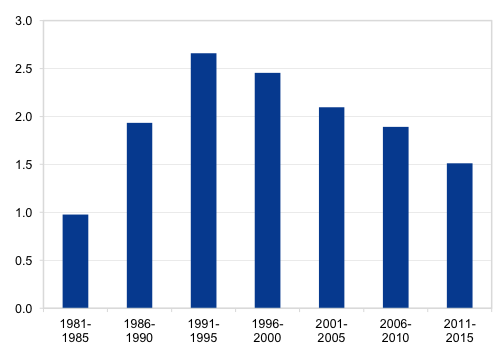The Great Normalisation of Global Trade
By Alexander Al-Haschimi, Economist, External Developments Division, ECB, Martin Gächter, Economist, Directorate General International and European Relations, ECB, David Lodge, Principal Economist, External Developments Division, ECB, and Walter Steingress, Research Economist in the International Macroeconomic Division, Banque de France; research affiliate; IZA. Originally published at VoxEU.
Exceptionally weak global trade growth over recent years has presented a puzzle to academics and policymakers alike.1 Annual world import growth has fallen below its long-run average since mid-2011 and remained there since, representing the longest period of below-trend growth in nearly half a century. Even more importantly, the link between global production and trade appears to have changed.2 While global trade grew at approximately twice the rate of global GDP prior to the Global Crisis, the share of trade in global GDP has discontinued its strong upward trend and largely stagnated over recent years (Figure 1).
Figure 1. Ratio of Global Imports to GDP (ratio of levels, quarterly data)

Source: National sources.
Notes: Real imports of goods and services. Real global GDP is aggregated
Notes: Real imports of goods and services. Real global GDP is aggregated
with market exchange
rates. The last observation refers to 2015Q4.
Pre-crisis trade elasticities have, however, also shown considerable variation over time, with the ratio of global import to GDP growth fluctuating significantly prior to the Great Recession (Figure 2). In fact, the growth ratio peaked in the mid-1990s, and has gradually declined thereafter.3 A recent study by an expert network of European central banks4 finds that the decline in this ratio is primarily due to structural factors, which had temporarily lifted the income elasticity of trade significantly above unity (IRC Task Force 2016). More recently, these push factors have largely run their course and thus provide less support to trade growth. From this perspective, the current environment therefore reflects a normalisation of the trade elasticity towards its long-run value of unity.
Figure 2. Ratio of Global Import Growth to Global GDP Growth (ratio of growth rates; annual data)

Source: IMF WEO.
Notes: Real imports of goods and services. Real global GDP is aggregated
Notes: Real imports of goods and services. Real global GDP is aggregated
with market exchange rates.
The last observation refers to 2015.
Specifically, the study shows that the change in the global trade-income relationship between the pre-crisis period and more recent years is driven by both compositional as well as structural effects. The former are not necessarily structural and can reverse over the medium term. The latter, on the other hand, alter the fundamental relationship between trade and economic activity also at the country level. These two factors each contribute roughly half to the overall decline in the trade elasticity, respectively....MORE